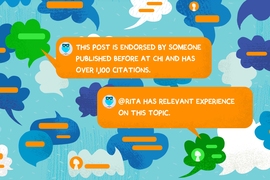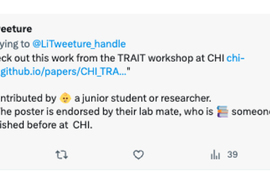Have you ever felt reluctant to share ideas during a meeting because you feared judgment from senior colleagues? You’re not alone. Research has shown this pervasive issue can lead to a lack of diversity in public discourse, especially when junior members of a community don’t speak up because they feel intimidated.
Anonymous communication can alleviate that fear and empower individuals to speak their minds, but anonymity also eliminates important social context and can quickly skew too far in the other direction, leading to toxic or hateful speech.
MIT researchers addressed these issues by designing a framework for identity disclosure in public conversations that falls somewhere in the middle, using a concept called “meronymity.”
Meronymity (from the Greek words for “partial” and “name”) allows people in a public discussion space to selectively reveal only relevant, verified aspects of their identity.
The researchers implemented meronymity in a communication system they built called LiTweeture, which is aimed at helping junior scholars use social media to ask research questions.
In LiTweeture, users can reveal a few professional facts, such as their academic affiliation or expertise in a certain field, which lends credibility to their questions or answers while shielding their exact identity.
Users have the flexibility to choose what they reveal about themselves each time they compose a social media post. They can also leverage existing relationships for endorsements that help queries reach experts they otherwise might be reluctant to contact.
During a monthlong study, junior academics who tested LiTweeture said meronymous communication made them feel more comfortable asking questions and encouraged them to engage with senior scholars on social media.
And while this study focused on academia, meronymous communication could be applied to any community or discussion space, says electrical engineering and computer science graduate student Nouran Soliman.
“With meronymity, we wanted to strike a balance between credibility and social inhibition. How can we make people feel more comfortable contributing and leveraging this rich community while still having some accountability?” says Soliman, lead author of a paper on meronymity.
Soliman wrote the paper with her advisor and senior author David Karger, professor in the Department of Electrical Engineering and Computer Science and a member of the Computer Science and Artificial Intelligence Laboratory (CSAIL), as well as others at the Semantic Scholar Team at Allen Institute for AI, the University of Washington, and Carnegie Mellon University. The research will be presented at the ACM Conference on Human Factors in Computing Systems.
Breaking down social barriers
The researchers began by conducting an initial study with 20 scholars to better understand the motivations and social barriers they face when engaging online with other academics.
They found that, while academics find X (formerly called Twitter) and Mastodon to be key resources when seeking help with research, they were often reluctant to ask for, discuss, or share recommendations.
Many respondents worried asking for help would make them appear to be unknowledgeable about a certain subject or feared public embarrassment if their posts were ignored.
The researchers developed LiTweeture to enable scholars to selectively present relevant facets of their identity when using social media to ask for research help.
But such identity markers, or “meronyms,” only give someone credibility if they are verified. So the researchers connected LiTweeture to Semantic Scholar, a web service which creates verified academic profiles for scholars detailing their education, affiliations, and publication history.
LiTweeture uses someone’s Semantic Scholar profile to automatically generate a set of meronyms they can choose to include with each social media post they compose. A meronym might be something like, “third-year graduate student at a research institution who has five publications at computer science conferences.”
A user writes a query and chooses the meronyms to appear with this specific post. LiTweeture then posts the query and meryonyms to X and Mastodon.
The user can also identify desired responders — perhaps certain researchers with relevant expertise — who will receive the query through a direct social media message or email. Users can personalize their meronyms for these experts, perhaps mentioning common colleagues or similar research projects.
Sharing social capital
They can also leverage connections by sharing their full identity with individuals who serve as public endorsers, such as an academic advisor or lab mate. Endorsements can encourage experts to respond to the asker’s query.
“The endorsement lets a senior figure donate some of their social capital to people who don’t have as much of it,” Karger says.
In addition, users can recruit close colleagues and peers to be helpers who are willing to repost their query so it reaches a wider audience.
Responders can answer queries using meronyms, which encourages potentially shy academics to offer their expertise, Soliman says.
The researchers tested LiTweeture during a field study with 13 junior academics who were tasked with writing and responding to queries. Participants said meronymous interactions gave them confidence when asking for help and provided high-quality recommendations.
Participants also used meronyms to seek a certain kind of answer. For instance, a user might disclose their publication history to signal that they are not seeking the most basic recommendations. When responding, individuals used identity signals to reflect their level of confidence in a recommendation, for example by disclosing their expertise.
“That implicit signaling was really interesting to see. I was also very excited to see that people wanted to connect with others based on their identity signals. This sense of relation also motivated some responders to make more effort when answering questions,” Soliman says.
Now that they have built a framework around academia, the researchers want to apply meronymity to other online communities and general social media conversations, especially those around issues where there is a lot of conflict, like politics. But to do that, they will need to find an effective, scalable way for people to present verified aspects of their identities.
“I think this is a tool that could be very helpful in many communities. But we have to figure out how to thread the needle on social inhibition. How can we create an environment where everyone feels safe speaking up, but also preserve enough accountability to discourage bad behavior? says Karger.
“Meronymity is not just a concept; it's a novel technique that subtly blends aspects of identity and anonymity, creating a platform where credibility and privacy coexist. It changes digital communications by allowing safe engagement without full exposure, addressing the traditional anonymity-accountability trade-off. Its impact reaches beyond academia, fostering inclusivity and trust in digital interactions,” says Saiph Savage, assistant professor and director of the Civic A.I. Lab in the Khoury College of Computer Science at Northeastern University, and who was not involved with this work.
This research was funded, in part, by Semantic Scholar.














